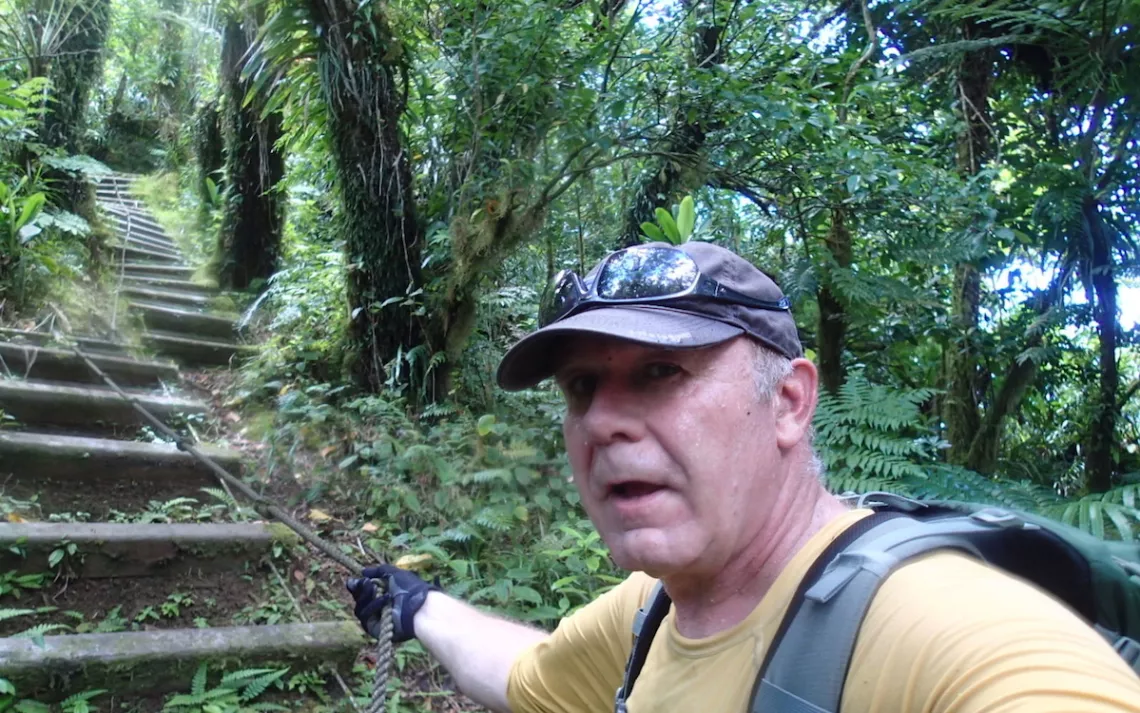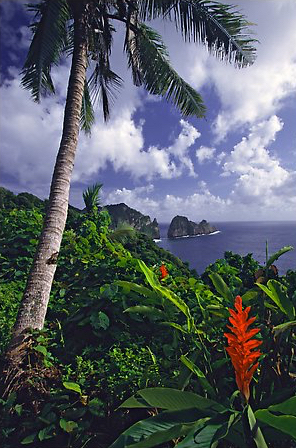Tracing the Spine of the Pacific
The ‘Alava Trail offers a journey through America’s only paleotropic rainforest

Photo by Marc Hess
A dense curtain of bamboo-like flagellaria vines stops me just a few hundred feet from the trailhead. Running from the sun-speckled canopy to the mushy trail below, the vines are firm and not easily pushed aside. It seems to me as if they guard the fragile rainforest ahead. Threading my way through them to the muddy approaches of the Maugaloa Ridge, I am careful not to tromp on the rare vegetation: a tailing fern with countless shades of green; a wild red hibiscus that seems to take tiny breaths as it pushes out its yellow-capped pistil searching for sunlight. I am overwhelmed by the uncorrupted beauty and frightening vulnerability of America’s only paleotropic rainforest. Poking out of the South Pacific Ocean on a volcanic sea mound halfway between Honolulu and Auckland, New Zealand, this ridge on American Samoa is the most far-flung of the United States’ national parks and the only one south of the equator.
Looking south from the 1,610-foot peak of Mount ‘Alava, I see how the length of Pago Pago’s deep-water harbor almost cleaves the island of Tutuila in two. I turn the other way to face the wind and peer over the Vai’ava Strait to the seemingly endless waters of the South Pacific. The Mount ‘Alava Trail is only seven miles long, but it is as challenging as it is beautiful. Shaded by a canopy of palms pushing themselves above the Diospyros thickets, the trail cuts through dense hedges of wild ginger flowers and banana trees. All the while, I am accompanied by the steady chip-chip-chip calls of the Tahitian petrel, a bird listed as near threatened by Bird Life International. What makes this rainforest paleotropic is its similarity to the ancient rainforests that wrap themselves around the tropics of Africa and Asia and through equatorial Oceania. The climb to the peak takes me through the most diverse range of plant life that I have ever seen.
 Photo courtesy of QT LuongThe peak of Mount ‘Alava is where the adventure begins. A scant 200 to 300 visitors make it to the summit every year. But even fewer, a hundred or less, continue along the ridgeline to the trail's end in the village of Vatia, which is where I’m headed. The Maugaloa Ridge is a lava razorback, steep on both sides with only two ways to go—up or down. Beyond the peak, the ridgeline narrows and becomes more serrated, which requires scrambling on hands and knees to make my way along its undulating backbone. I’m relieved to come upon the first of the 56 rope ladders set up to assist hikers on the ascents and descents. But the fun turns to exhaustion by the time I am halfway through them—each one a steeper climb on a rope that is more frayed than the last.
Photo courtesy of QT LuongThe peak of Mount ‘Alava is where the adventure begins. A scant 200 to 300 visitors make it to the summit every year. But even fewer, a hundred or less, continue along the ridgeline to the trail's end in the village of Vatia, which is where I’m headed. The Maugaloa Ridge is a lava razorback, steep on both sides with only two ways to go—up or down. Beyond the peak, the ridgeline narrows and becomes more serrated, which requires scrambling on hands and knees to make my way along its undulating backbone. I’m relieved to come upon the first of the 56 rope ladders set up to assist hikers on the ascents and descents. But the fun turns to exhaustion by the time I am halfway through them—each one a steeper climb on a rope that is more frayed than the last.
The only fork in the trail is well marked, with a sign in park-service brown that reads “Old Vatia Trail/Closed on Sunday.” I follow that trail as it drops sharply down the northern slope. The pleasant jungle switchbacks soon become steep and covered with layer upon layer of dry leaves.
The village of Vatia is nestled on a slow curve of turquoise reef and shoved up against the jungle greenery. The trail terminus is a bit anticlimactic—a meandering route through backyards and small packs of barking dogs. I’m thirsty from the vigorous trek, but the public water here is too salty for me to drink.
Vatia marks not only the end of the ‘Alava Trail but also the endpoint of the great expanse of rainforests that begin in Southeast Asia, cross to New Guinea, and remain largely intact as they work their way, from island to island, to the place where I now stand. Waiting in the crooked shade of a banyan for a lift back to the market in Pago Pago, I fall into a chat with some local guys. “You came from up there?” one asks. “There’s an easier way to get to the market, you know.” They tell me that they don’t go up there. As our aiga (a brightly painted family bus) approaches, I scan the folds of those ridges one last time with a smile of accomplishment as one of the few who have experienced the wonder of this rare rainforest.
 The Magazine of The Sierra Club
The Magazine of The Sierra Club



